Several of us presented at the recent Roman Coronagraph Instrument Information Sessions, held virtually on October 26th and 28th. Slides and recordings of all talks are available here. Also, check out the results of the Coronagraph Science Investigation Team at
SIOSlab Contributes to the Decadal Survey
Last week, the National Academies released the Astro2020 decadal survey in Astronomy and Astrophysics: Pathways to Discovery in Astronomy and Astrophysics for the 2020s. SIOSlab is proud to have contributed to the survey, alongside many of our colleagues at Cornell.
Congratulations to Corey Spohn on Passing his A Exam!
Corey Spohn successfully passed his A exam, marking the entrance into the dissertation phase of his degree program. His public talk can be seen below.
ApJL Paper Published
Our latest paper, Keithly & Savransky, “The Solar System as an Exosystem: Planet Confusion“, is now published in the Astrophysical Journal Letters. This work explores the idea of what we can learn about observing other planetary systems by thinking about
JATIS Paper Published
Our newest paper: Keithly, Savransky, and Spohn, “Integration Time Adjusted Completeness” is now available as open access in the Journal of Astronomical Telescopes, Instruments, and Systems. This paper updates the concept of completeness—the probability of detecting an exoplanet from some
On Nutation Dampers
I’ve been teaching the theory of nutation dampers for years, and have finally gotten around to creating a good visualization of one. Nutation dampers are really neat devices for rejecting disturbances on spin-stabilized spacecraft. Essentially, a damper is any mechanical
On Detecting Exoplanets
Here is a lecture I recently did on techniques for the detection of exoplanets: A related video illustrating some of the methods:
On Space Telescopes
I recently had the opportunity to do a guest lecture on astronomy space missions. See below for some fun facts about Hubble and other space telescopes.
Automating Away Life’s Annoyances
For my CV, I like to include a table of citation metrics from multiple sources (currently Google Scholar, ADS and Web of Science). Updating these manually, however, is torturous, and feels like something that should be trivially automatable. I recently
An Aural Experiment
Every year or so, I update my ‘history of exoplanet exploration’ animation, which shows the detections of exoplanets in (roughly) the order of their discovery by plotting the host star locations in sequence. This year, I decided that I wanted
